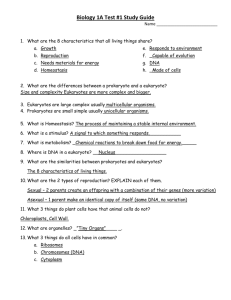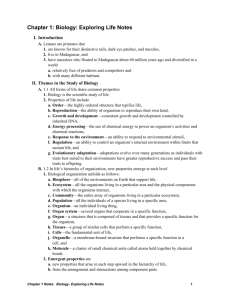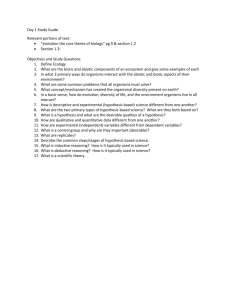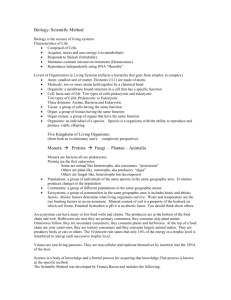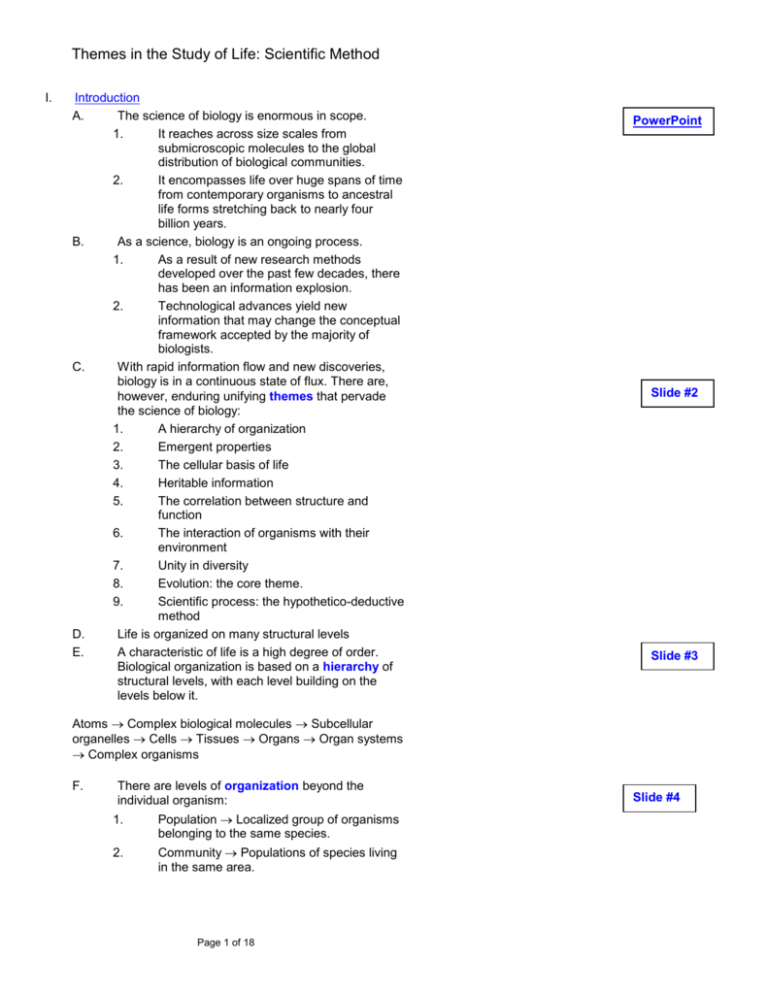
Themes in the Study of Life: Scientific Method
I.
Introduction
A.
The science of biology is enormous in scope.
1.
It reaches across size scales from
submicroscopic molecules to the global
distribution of biological communities.
2.
It encompasses life over huge spans of time
from contemporary organisms to ancestral
life forms stretching back to nearly four
billion years.
B.
As a science, biology is an ongoing process.
1.
As a result of new research methods
developed over the past few decades, there
has been an information explosion.
2.
Technological advances yield new
information that may change the conceptual
framework accepted by the majority of
biologists.
C.
With rapid information flow and new discoveries,
biology is in a continuous state of flux. There are,
however, enduring unifying themes that pervade
the science of biology:
1.
A hierarchy of organization
2.
Emergent properties
3.
The cellular basis of life
4.
Heritable information
5.
The correlation between structure and
function
6.
The interaction of organisms with their
environment
7.
Unity in diversity
8.
Evolution: the core theme.
9.
Scientific process: the hypothetico-deductive
method
D.
Life is organized on many structural levels
E.
A characteristic of life is a high degree of order.
Biological organization is based on a hierarchy of
structural levels, with each level building on the
levels below it.
PowerPoint
Slide #2
Slide #3
Atoms Complex biological molecules Subcellular
organelles Cells Tissues Organs Organ systems
Complex organisms
F.
There are levels of organization beyond the
individual organism:
1.
Population Localized group of organisms
belonging to the same species.
2.
Community Populations of species living
in the same area.
Page 1 of 18
Slide #4
Themes in the Study of Life: Scientific Method
3.
Ecosystem An energy-processing system
of community interactions that include abiotic
environmental factors such as soil and water
4.
Biomes Large scale communities
classified by predominant vegetation type
and distinctive combinations of plant s and
animals
Biosphere The sum of all the planet's
ecosystems.
II.
Each level of biological organization has emergent
properties
A.
Emergent property = Property that emerges as a
result of interactions between components.
1.
With each step upward in the biological
hierarchy, new properties emerge that were
not present at the simpler organizational
levels.
2.
Life is difficult to define because it is
associated with numerous emergent
properties that reflect a hierarchy of
structural organization.
B.
Some of the emergent properties and processes
associated with life are:
1.
Order. Organisms are highly ordered, and
other characteristics of life emerge from this
complex organization.
2.
Reproduction. Organisms reproduce; life
comes only from life (biogenesis).
3.
Growth and Development. Heritable
programs stored in DNA direct the speciesspecific pattern of growth and development.
4.
Energy Utilization. Organisms take in and
transform energy to do work, including the
maintenance of their ordered state.
5.
Response to Environment. Organisms
respond to stimuli from their environment.
6.
Homeostasis. Organisms regulate their
internal environment to maintain a steadystate, even in the face of a fluctuating
external environment.
7.
Evolutionary Adaptation. Life evolves in
response to interactions between organisms
and their environment.
C.
Because properties of life emerge from complex
organization, it is impossible to fully explain a higher
level of order by breaking it into its parts.
D.
Holism = The principle that a higher level of order
cannot be meaningfully explained by examining
component parts in isolation.
5.
Page 2 of 18
Slide #5
Themes in the Study of Life: Scientific Method
1.
An organism is a living whole greater than
the sum of its parts.
2.
For example, a cell dismantled to its
chemical ingredients is no longer a cell.
E.
It is also difficult to analyze a complex process
without taking it apart.
F.
Reductionism = The principle that a complex
system can be understood by studying its
component parts.
1.
Has been a powerful strategy in biology.
2.
For example, Watson and Crick deduced the
role of DNA in inheritance by studying its
molecular structure.
G.
The study of biology balances the reductionist
strategy with the goal of understanding how the
parts of cells, organisms and populations are
functionally integrated.
III.
Cell's are an organism's basic units of structure and
function
A.
The cell is an organism's basic unit of structure and
function.
1.
Lowest level of structure capable of
performing all activities of life.
2.
All organisms are composed of cells.
3.
May exist singly as unicellular organisms or
as subunits of multicellular organisms.
B.
The invention of the microscope led to the discovery
of the cell and the formulation of the cell theory.
1.
Robert Hooke (1665) reported a description
of his microscopic examination of cork.
2.
Hooke described tiny boxes which he called
"cells" (really cell walls). The significance of
this discovery was not recognized until 150
years later.
3.
Antonie van Leeuwenhok (1600's) used the
microscope to observe living organisms
such as microorganisms in pond water,
blood cells and animal sperm cells.
4.
Matthias Schleiden and Theodor Schwann
(1839) reasoned from their own microscopic
studies and those of others, that all living
things are made of cells. This formed the
basis for the cell theory.
5.
The cell theory has since been modified to
include the idea that all cells come from
preexisting cells.
C.
Over the past 40 years, use of the electron
microscope has revealed the complex ultrastructure
of cells:
Page 3 of 18
Slide #6
Themes in the Study of Life: Scientific Method
1.
Cells are bounded by plasma membranes
that regulate passage of materials between
cell and its surroundings.
2.
All cells, at some stage, contain DNA.
D.
Based on structural organization, there are two
major kinds of cells: prokaryotic and eukaryotic.
E.
Prokaryotic cell = Cell lacking membrane-bound
organelles and a membrane-enclosed nucleus.
1.
Found only in the Kingdom Monera, the
bacteria and blue-green algae.
2.
Generally much smaller than eukaryotic
cells.
3.
Contains DNA that is not separated from the
rest of the cell, as there is no membranebound nucleus.
4.
Lacks membrane-bound organelles.
5.
Almost all have tough external walls.
F.
Eukaryotic cell = Cell with a membrane-enclosed
nucleus and membrane-enclosed organelles.
1.
Found in protists, plants, fungi and animals.
2.
Subdivided by internal membranes into
different functional compartments called
organelles.
3.
Contains DNA that is segregated from the
rest of the cell. DNA is organized with
proteins into chromosomes that are located
within the nucleus, the largest organelle of
most cells.
4.
Cytoplasm surrounds the nucleus and
contains various organelles of different
functions.
5.
Some cells have a tough cell wall outside the
plasma membrane (e.g. plant cells). Animal
cells lack cell walk
G.
Though structurally different, eukaryotic and
prokaryotic cells have many similarities, especially
in their chemical processes.
IV.
The continuity of life is based on heritable information in
the form of DNA
A.
Biological instructions for an organism's complex
structure and function are encoded in DNA,
1.
Each DNA molecule is made of four types of
chemical building blocks called nucleotides.
2.
The linear sequence of these four
nucleotides encodes the precise information
in a gene, the unit of inheritance from parent
to offspring.
3.
An organism's complex structural
organization is specified by an enormous
amount of coded information,
Page 4 of 18
Slide #7
Slide #8
Slide #9
Slide #10
Themes in the Study of Life: Scientific Method
B.
Inheritance itself is based on:
1.
A complex mechanism for copying DNA.
2.
Passing the information encoded in DNA
from parent to offspring.
C.
All forms of life use essentially the same genetic
code.
1.
A particular nucleotide sequence provides
the same information to one organism as it
does to another.
2.
Differences among organisms reflect
differences in nucleotide sequence.
V.
Structure and function are correlated at all levels of
biological organization
A.
There is a relationship between an organism's
structure and how it works. Form fits function.
1.
Biological structure gives clues about what it
does and how it works.
2.
Knowing a structure's function gives insights
about its construction.
3.
This correlation is apparent at many levels of
biological organization. (See Campbell,
Figure 1.7)
VI.
Organisms are open systems that interact continuously
with their environments
A.
Organisms interact with their environment, which
includes other organisms as well as abiotic factors.
1.
Both organism and environment are affected
by the interaction between them.
2.
Ecosystem dynamics include two major
processes:
a)
Nutrient cycling.
b)
Energy flow.
VII.
Regulatory mechanisms ensure a dynamic balance in
living systems
A.
No such thing as “balance of nature” – the
biosphere is constantly changing but may be
considered in a dynamic balance, that is short term
B.
Most regulation is by negative feedback
mechanisms or homeostasis
Page 5 of 18
Slide #11
Slide #12
Slide #13
Themes in the Study of Life: Scientific Method
Positive or
Runaway
Feedback
Negative
Feedback
Upward
Deviation (+)
Set point
Downward
Deviation
C.
D.
E.
VIII.
A.
B.
C.
Set point
(-)
Positive or
Runaway
Feedback
Negative
Feedback
Feedback
1.
Any return to the set point is negative
feedback
2.
Any deviation further away from the set point
is positive feedback
There is no connotation of good or bad in the terms
negative and positive
Example: Thermoregulation
Diversity and unity are the dual faces of life on Earth
Biological diversity is enormous.
1.
Estimates of total diversity range from 5
million to over 30 million species.
2.
About 1.5 million species have been
identified and named, including
approximately 260,000 plants, 50,000
vertebrates and 750,000 insects.
To make this diversity more comprehensible,
biologists classify species into categories.
Taxonomy = Branch of biology concerned with
naming and classifying organisms.
1.
Taxonomic groups are ranked into a
hierarchy from the most to least inclusive
category: kingdom, phylum, class, order,
family, genus, species.
2.
The kingdoms of life recognized in the fivekingdom system are: Monera, Protista,
Plantae, Fungi and Animalia. (See
Campbell, Figure 1. 10)
3.
A six-kingdom system recognizes two
prokaryotic groups and divides the Monera
into the Archaebacteria and Eubacteria.
Page 6 of 18
Slide #14
Themes in the Study of Life: Scientific Method
Slide #15
D.
There is unity in the diversity of life forms at the
lower levels of organization. Unity of life forms is
evident in:
1.
A universal genetic code.
2.
Similar metabolic pathways (e.g. glycolysis).
3.
Similarities of cell structure (e.g. flagella of
protozoans and mammalian sperm cells).
IX.
Evolution is the core theme of biology
A.
Evolution is the one unifying biological theme.
1.
Life evolves. Species change over time and
their history can be described as a branching
tree of life.
2.
Species that are very similar share a
common ancestor at a recent branch point
on the phylogenetic tree.
3.
Less closely related organisms share a more
ancient common ancestor.
4.
All life is connected and can be traced back
to primeval prokaryotes that existed more
than three billion years ago.
B.
In 1859, Charles Darwin published On the Origin of
Species in which he made two major points:
Page 7 of 18
Slide #16
Themes in the Study of Life: Scientific Method
1.
X.
Species change, and contemporary species
arose from a succession of ancestors
through a process of "descent with
modification."
2.
A mechanism of evolutionary change is
natural selection.
C.
Darwin synthesized the concept of natural
selection based upon the following observations:
1.
Individuals in a population of any species
vary in many inheritable traits.
2.
Populations have the potential to produce
more offspring than will survive or than the
environment can support.
3.
Individuals with traits best suited to the
environment leave a larger number of
offspring, which increases the proportion of
inheritable variations in the next generation.
This differential reproductive success is what
Darwin called natural selection.
D.
Organisms' adaptations to their environments are
the products of natural selection.
1.
Natural selection does not create
adaptations; it merely increases the
frequency of inherited variants that arise by
chance.
2.
Adaptations are the result of the editing
process of natural selection. When exposed
to specific environmental pressures, certain
inheritable variations favor the reproductive
success of some individuals over others.
E.
Darwin proposed that cumulative changes in a
population over long time spans could produce a
new species from an ancestral one.
F.
Descent with modification accounts for both the
unity and diversity of life:
1.
Similarities between two species may be a
reflection of their descent from a common
ancestor.
2.
Differences between species may be the
result of natural selection modifying the
ancestral equipment in different
environmental contexts.
The Nature of Science
A.
Studying Natural Phenomenon
1.
Diversity of ways
2.
Rules, definitions and approaches
3.
Zen, poet, musician, novelist
4.
What is truth? Does anyone have a
monopoly on truth?
Page 8 of 18
Slide #17
Slide #18
Slide #19
Themes in the Study of Life: Scientific Method
5.
Is there a correct way to study natural
phenomena?
Science is one approach
1.
Science is a method and not a belief!
a)
Science does not claim to be able to
answer or explain everything
b)
Science changes constantly, altering
explanations (theories) to conform to
empirical evidence
2.
Religion is a belief and requires faith and
claims answers and explanations for all
things.
a)
Definition of faith: unquestioned
belief, reliance, trust
b)
Based on unchanging dogma or
doctrine without supporting evidence
B.
faith (fāth) noun
1.
Confident belief in the truth, value, or trustworthiness
of a person, an idea, or a thing.
2.
Belief that does not rest on logical proof or material
evidence. See synonyms at belief, trust.
3.
Loyalty to a person or thing; allegiance: keeping faith
with one's supporters.
4.
Often Faith Theology. The theological virtue defined as
secure belief in God and a trusting acceptance of God's
will.
5.
The body of dogma of a religion: the Muslim faith.
6.
A set of principles or beliefs. ]1
1Excerpted from The American Heritage Dictionary of the
English Language, Third Edition Copyright © 1992 by
Houghton Mifflin Company. Electronic version licensed from
Lernout & Hauspie Speech Products N.V., further reproduction
and distribution restricted in accordance with the Copyright
Law of the United States. All rights reserved.
Page 9 of 18
Themes in the Study of Life: Scientific Method
3.
Empirical evidence - evidence based on
scientific experimentation
em·pir·i·cal (ĕm-pîrʹ ĭ-kəl) adjective
1. a. Relying on or derived from observation or experiment:
empirical results that supported the hypothesis. b.
Verifiable or provable by means of observation or
experiment: empirical laws.
2. Guided by practical experience and not theory, especially
in medicine.
C.
Science is a method and is based on definitions not
empirical evidence, that is a tautology In logic an
empty or vacuous statement composed of simpler
statements in a fashion that makes it logically true
whether the simpler statements are factually true or false;
for example, the statement Either it will rain tomorrow or
it will not rain tomorrow.
D.
E.
Science versus technology versus medicine
Science is experimentation, gathering empirical
evidence
XI.
Misuses of science
A.
BELIEVE TO BE TRUE VERSUS KNOW TO BE
TRUE
1.
Cranberry juice example - common practice
from a clinical note, 1962, on ONE sixty-six
year old woman
a)
No scientific evidence for this
"traditional" practice
b)
Not enough hippuric acid to lower
acidity of urine to kill any bacteria in
"cranberry cocktail" - straight
cranberry juice will pucker a person
for 723 days!
2.
Common cold and myths, nutrition of crust
on bread
3.
Nutrition myths - "You can't prove it doesn't
work therefore it must be valid." - illogical
4.
"Allergies" - lack of understanding of
meaning
5.
Sugar "addiction" or "allergy"
(Woman who claimed she was allergic to
sodium!)
B.
Low sample size, n
C.
Anecdotal and testimonial evidence - true believers
1.
Chiropractic
2.
Iridology
3.
Herbal Life
D.
Spurious conclusions
Page 10 of 18
Slide #20
Slide #21
Themes in the Study of Life: Scientific Method
1.
Marijuana, alcohol and driving - U. of
Washington study
2.
Rockefeller quote to his Sunday school class
3.
Billy James Hargis and chromosomes
4.
Feingold and nutrition for hyperactivity
E.
Science and political gain
1.
Stalin & Lysenko
2.
Racists
F.
Overuse of science - Cigarette industry and
evidence for lung cancer
G.
"She makes housekeeping into a science." meaningless, being orderly and organized is not
necessarily a scientific activity but it helps
H.
If someone makes a claim about something it is up
to him or her to present the evidence to support the
claim it is NOT up to the listener to disprove it.
I.
Typical signs of fraudulent claims include:
1.
Products advertised as effective against a
wide range of ailments
2.
Use of terms like scientific breakthrough,
miraculous cure, ancient remedy, etc.
3.
Impressive sounding terminology to disguise
a lack of good science
4.
Claims the government or the medical
profession have conspired to suppress the
product
5.
Testimonials instead of facts and figures
6.
Product availability from only one source
XII.
Science as a process of inquiry often involves
hypothetico-deductive thinking
A.
As the science of life, biology has the characteristics
associated with science in general.
B.
Science is a way of knowing. It is a human
endeavor that emerges from our curiosity about
ourselves, the world and the universe. Good
scientists are people who:
1.
Ask questions about nature and believe
those questions are answerable.
2.
Are curious, observant and passionate in
their quest for discovery.
3.
Are creative, imaginative and intuitive.
4.
Are generally skeptics.
C.
The key ingredient of the scientific process is the
hypothetico-deductive method, which is an
approach to problem-solving that involves:
1.
Asking a question and formulating a
tentative answer or hypothesis by inductive
reasoning.
Page 11 of 18
Slide #22
Themes in the Study of Life: Scientific Method
2.
D.
E.
F.
G.
Using deductive reasoning to make
predictions from the hypothesis and then
testing the validity of those predictions.
Hypothesis = Educated guess proposed as a
tentative answer to a specific question or problem.
Inductive reasoning = Making an inference from a
set of specific observations to reach a general
conclusion. Process of deriving general principles
from particular facts or instances
Deductive reasoning = Making an inference from
general premises to specific consequences,
which logically follow if the premises are true.
1.
The process of reasoning in which a
conclusion follows necessarily from the
stated premises; inference by reasoning
from the general to the specific
2.
Usually takes the form of If.. then logic.
3.
In science, deductive reasoning usually
involves predicting experimental results that
are expected if the hypothesis is true.
Useful hypotheses have the following
characteristics:
1.
Hypotheses are possible causes.
Generalizations formed by induction are not
necessarily hypotheses. Hypotheses should
also be tentative explanations for
observations or solutions to problems.
2.
Hypotheses reflect past experience with
similar questions. Hypotheses are not just
blind propositions, but are educated guesses
based upon available evidence.
3.
Multiple hypotheses should be proposed
whenever possible. The disadvantage of
operating under only one hypothesis is that it
might restrict the search for evidence in
support of this hypothesis; scientists might
bias their search, as well as neglect to
consider other possible solutions.
4.
Hypotheses must be testable via the
hypothetico-deductive method. Predictions
made from hypotheses must be testable by
making observations or performing
experiments. This limits the scope of
questions that science can answer.
5.
Hypotheses can be eliminated, but not
confirmed with absolute certainty. If repeated
experiments consistently disprove the
predictions, then we can assume that the
hypothesis is false. However, if repeated
experimentation supports the deductions, we
can only assume that the hypothesis may be
true; accurate predictions can be made from
Page 12 of 18
Slide #23
Themes in the Study of Life: Scientific Method
H.
I.
J.
K.
L.
false hypotheses. The more deductions that
are tested and supported, the more
confident we can be that the hypothesis is
true.
Another feature of the scientific process is the
controlled experiment which includes control and
experimental groups.
Control group = In a controlled experiment, the
group in which all variables are held constant.
1.
Controls are a necessary basis for
comparison with the experimental group,
which has been exposed to a single
treatment variable.
2.
Allows conclusions to be made about the
effect of experimental manipulation.
3.
Setting up the best controls is a key element
of good experimental design.
Variable = Condition of an experiment that is subject
to change and that may influence an experiment's
outcome.
Experimental group = In a controlled experiment,
the group in which one factor or treatment is
varied.
Science is an ongoing process that is a selfcorrecting way of knowing. Scientists:
1.
Build on prior scientific knowledge.
2.
Try to replicate the observations and
experiments of others to check on their
conclusions.
Page 13 of 18
Slide #24
Themes in the Study of Life: Scientific Method
3.
M.
N.
O.
XIII.
A.
Share information through publications,
seminars, meetings and personal
ommunication.
What really advances science is not just an
accumulation of facts, but a new concept that
collectively explains observations that previously
seemed to be unrelated.
1.
Newton, Darwin and Einstein stand out in the
history of science because they synthesized
ideas with great explanatory power.
2.
Scientific theories are comprehensive
conceptual frameworks that are well
supported by evidence and are widely
accepted by the scientific community.
Biology is a multi-disciplinary science that requires
knowledge of chemistry, physics and mathematics.
Process which outlines a series of steps used to
answer questions.
1.
Is not a rigid procedure.
2.
Based on the conviction that natural
phenomena have natural causes.
3.
Requires evidence to logically solve
problems.
Scientific method - "Organized common sense"
Hierarchy of scientific method
1.
Observation
2.
Question
3.
Hypothesis
a)
Most important part of experiment
b)
A question that must be capable of
being answered yes or no
c)
Must match experiment
4.
Experimental design
a)
The experiment is designed to test
the hypothesis, that is when the
experiment is done can the
hypothesis be answered "yes" or
"no"
b)
Experiments are not designed to
prove anything or to discover
anything but to test an hypothesis
c)
Variable - a good experiment has
only ONE variable (mouse &
hairspray example)
d)
Controls - need as many controls as
necessary to ensure that there is
only one variable
e)
If at all possible results should be
quantified
Page 14 of 18
Themes in the Study of Life: Scientific Method
f)
g)
Numbers can be tested statistically
Results should be in tabular or
graphic form - no subjective
interpretation of data (data is plural,
datum is singular)
5.
Conclusion
a)
Here is where the results can be
discussed
b)
Discussion must have to do with the
hypothesis and results, not
something unrelated
B.
Possible errors of interpretation
1.
Anthropomorphism - ascribing human
attributes to nonhuman animals (love, hate,
greed, remorse etc)
2.
Teleology - (tee-lee-ahl'-uh-jee)
a)
"Birds evolved wings so they could
fly"
b)
"The course of evolution is toward
the perfection of a species"
c)
Have to be able to live with the
concept of "IS" without an ultimate
purpose attached to it
Teleology is the study of things or events in terms of their
purposes or ends. From ancient times to the present, many
philosophers and scientists have thought that various natural
processes could be explained only in terms of the purposes that
they were achieving or in terms of the ends or goals that they
were reaching. In Aristotle's physics, four types of explanation
were offered, but the most important one was in terms of the
purpose (Greek: telos), or final goal, of physical change. For
Aristotle all processes of change were purposeful. From the
examination of the world in terms of purpose and the discovery of
such apparent purposes, a teleological argument for the
existence of God was worked out, an argument claiming that the
purposes found in nature required a purposeful Designer, or
God.
In the development of modern science, one of the first
contentions of Galileo Galilei and Rene Descartes was that
purposes could neither be known nor discovered. Although
scientists have progressively removed teleological inquiry from
one branch of the study of nature after another, the central issue
remains: whether teleological explanation is necessary to
account for the behavior of living or conscious beings or whether
all of their behavior can be explained without it. RICHARD H.
POPKIN
Bibliography: Collins, James, Interpreting Modern Philosophy
(1972); Hull, David, Philosophy of Biological Science (1974);
McFarland, J. D., Kant's Concept of Teleology (1969); Taylor,
Charles, The Explanation of Behaviour (1964); Woodfield,
Page 15 of 18
Slide #25
Themes in the Study of Life: Scientific Method
Andrew, Teleology (1976); Wright, Larry, Teleological
Explanations (1976).
3.
4.
Subjectivity versus objectivity
Bias versus prejudice
a)
Bias - a view point based on past
experience and not necessarily
apparent to the individual - not a
planned sort of thing and is largely
unavoidable
b)
Prejudice - a view point held in
disregard to facts that contradict it
C.
Double-blind studies for humans
1.
Power of suggestion
2.
Placebo effect
XIV.
Probability
A.
Rules of probability are by definition
1.
Absolute certainty = 1
2.
Absolute uncertainty = 0
3.
Most probabilities fall somewhere in between
the two extremes
4.
Sum rule - the probability that one or another
of two independent events will occur is the
sum of their separate probabilities
a)
Probability that a coin flip will come
up with a head or a tail: 1/2 + 1/2 = 1
b)
Probability that a role of a die will
turn up a five or a six: 1/6 + 1/6 =1/3
5.
Product rule - if two events are independent
of each other, the probability of their
coinciding is the product of their individual
probabilities
6.
Odds of a game
a)
Probability of getting a head on a
coin toss and of getting a head on a
second toss is:
B.
C.
1/2 X 1/2 = 1/4
(1/2)2
b)
Probability of a male (0.50) with
blood type A (0.40) and being born
in June (1/12): 0.50 X 0.40 X 0.084
= 0.0168
The results and interpretations of experiments are
subject to statistical analysis
Mathematical calculations of probability versus "seat
of pants predicting" - Vegas trap
1.
Coin flip
2.
Role of dice, one die, two dice
3.
Gambling
Page 16 of 18
Slide #26
Slide #27
Themes in the Study of Life: Scientific Method
a)
b)
c)
d)
License plates
Birthdays
Odds of a game - Vegas
The "Gambler's Fallacy" - the odds
of a game will change with time
XV.
Normal Distribution
A.
Curve below – mean = 5, standard deviation = 1
Slide #28
Normal (Gaussian) Distribution
or Bell Shaped Curve
0.45
Mean = 5
0.4
0.35
Standard Deviation = 1
0.3
0.25
0.2
0.15
0.1
0.05
0
10.0 9.5
9.0
8.5
8.0
7.5
7.0
6.5
6.0
5.5
5.0
4.5
4.0
3.5
3.0
2.5
2.0
Normal distribution synonyms
1.
Gaussian curve
2.
Bell shaped curve
C.
Very important in testing if there is a significant
difference between two sets of data
D.
"Laws of Nature"
1.
Too simplistic way of viewing natural
phenomenon
2.
A scientific statement (theory) is a probability
statement and not necessarily true
a)
The theory can be used to make
predictions and formulate more
experiments but should never be
accepted as absolute
b)
Scientific inquiry would cease if so
called laws were accepted as
immutable
c)
Challenge to the law must be
presented with evidence, however
XVI.
Science and technology are functions of society
A.
Science and technology are interdependent.
1.
Technology extends our ability to observe
and measure, which enables scientists to
1.5
1.0
0.5
0.0
B.
Page 17 of 18
Slide #29
Themes in the Study of Life: Scientific Method
B.
C.
work on new questions that were previously
unapproachable.
2.
Science, in turn, generates new information
that makes technological inventions
possible.
3.
For example, Watson and Crick's scientific
discovery of DNA structure led to further
investigation that enhanced our
understanding of DNA, the genetic code,
and how to transplant foreign genes into
microorganisms. The biotechnology industry
has capitalized on this knowledge to produce
valuable pharmaceutical products such as
human insulin.
We have a love-hate relationship with technology.
1.
Technology has improved our standard of
living.
2.
The consequence of using technology also
includes the creation of new problems such
as increased population growth, acid rain,
deforestation, global warming, nuclear
accidents, ozone holes, toxic wastes and
endangered species.
3.
Solutions to these problems have as much
to do with politics, economics, culture and
values as with science and technology.
A better understanding of nature must remain the
goal of science. Scientists should:
1.
Try to influence how technology is used.
2.
Help educate the public about the benefits
and hazards of specific technologies.
Page 18 of 18

